Editor’s Note: This post is written by a member of LTV’s sponsored content team, The Leisure Explorers. Do you own a Leisure Travel Van and enjoy writing? Learn more about joining the team.
For many of us, our pets are important members of our family. Cute, furry, feathery, long hair or short hair, it doesn’t matter. They bring us companionship, unconditional love, acceptance, and sometimes an occasional mess. This is why when we decided to jump into the full-time RV life, there was no question we had to make sure our setup worked for our whole family, fur babies included. We began our journey with two small dogs and a cat, all elderly, which can create additional challenges. Here is a little bit about our experience.
Our Pet Story
As is typical of cats, Cleo was head of the household and insisted on approving all decisions, including travel routes.

Teddy and Brownie came into our lives in 2009 after the passing of our beloved German Shepherd Scooby. They immediately made their big personalities part of the family. Teddy is older by six months and is our high maintenance pup, he wants lots of attention and is super smart. Brownie is chill and loyal and will play ball for hours. Both are cockapoos from the same breeder but different litters.

In the summer of 2022, we sold most of our belongings and moved to Denver. We had added Cleo to our family in 2017 when we rescued her from an animal shelter. She was supposed to be four years old, but when we brought her to our vet for the first time, they informed us she was closer to nine years old—making her and the dogs about the same age. Three middle-aged pets, and we moved across the country to live in a city of more than three million people we had never visited.

As you can see from the picture above, they were agitated and unsettled! All of the pets adjusted with no problem. Our next move to our 25-foot Leisure Travel Van and full-time RV travel was as smooth as our move to Denver.

Each pet had more than enough space and was noticeably happier with us being around more, especially Teddy. Cleo had a love-hate relationship with the dogs; she terrified Teddy, and Brownie was indifferent to her. Once we had limited space, they all started to get along a little better and seemed to enjoy each other. Brownie and Cleo have passed since we began our RVing journey. Teddy, who is the oldest, is still experiencing a good life.
Voyager Was the Perfect Choice
Voyager is our 2022 Wonder RL Leisure Travel Van. We selected a Leisure Travel Van because of their quality. As full-time RVers, we wanted two separate living spaces, which the rear lounge provides. We also thought the additional space would help the pets be more comfortable. I also loved the openness and amount of natural light the large windows provide.
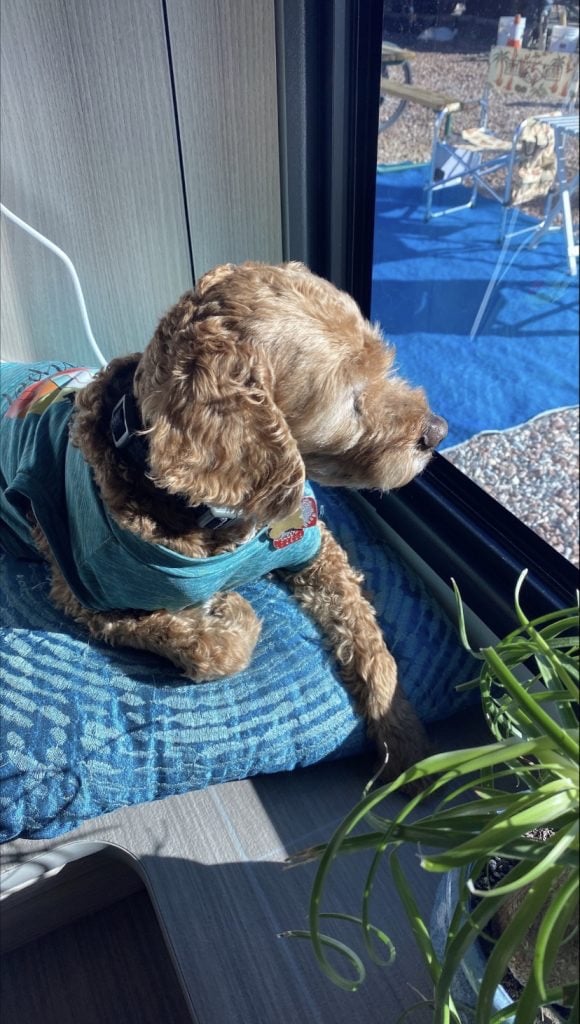
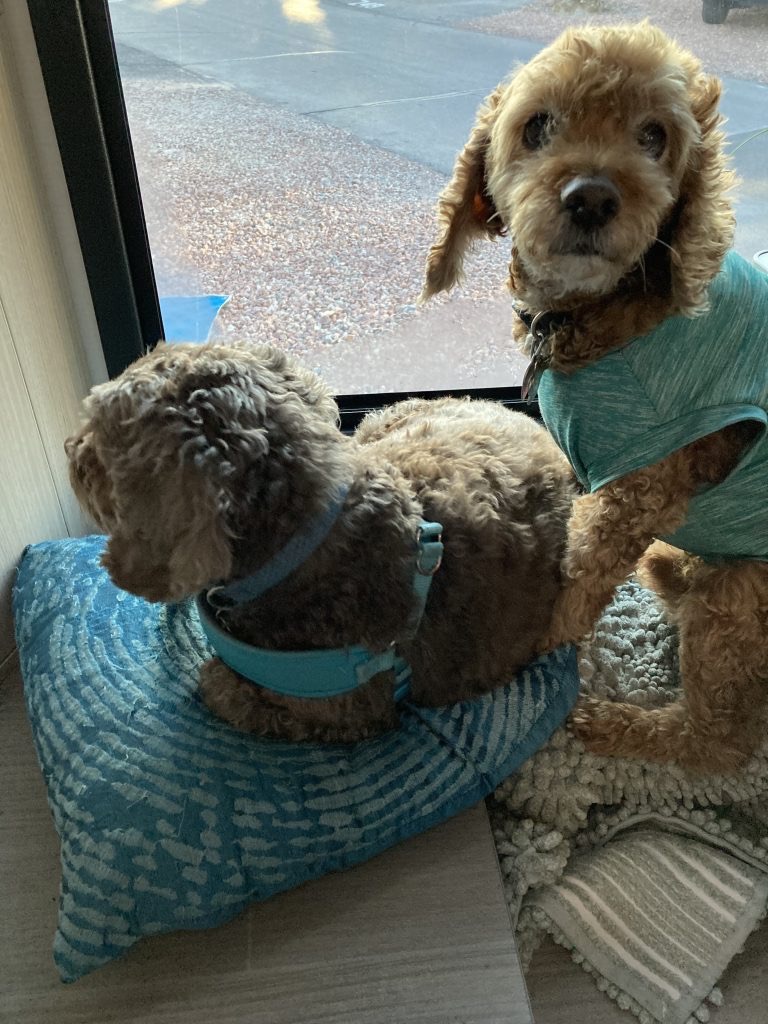
The first time I sat on the sofa in the Rear Lounge, I was sold, primarily because of the feeling the floor-to-ceiling windows provided. Our previous two homes had floor-to-ceiling windows, which I loved, and I was instantly comfortable. As you can see from the pictures, each of our pets also loves the window. All three spent a significant amount of their time both sleeping and not in that window. Teddy, our very curious pup, loves people-watching. Brownie, who was blind, enjoyed being in the sun.
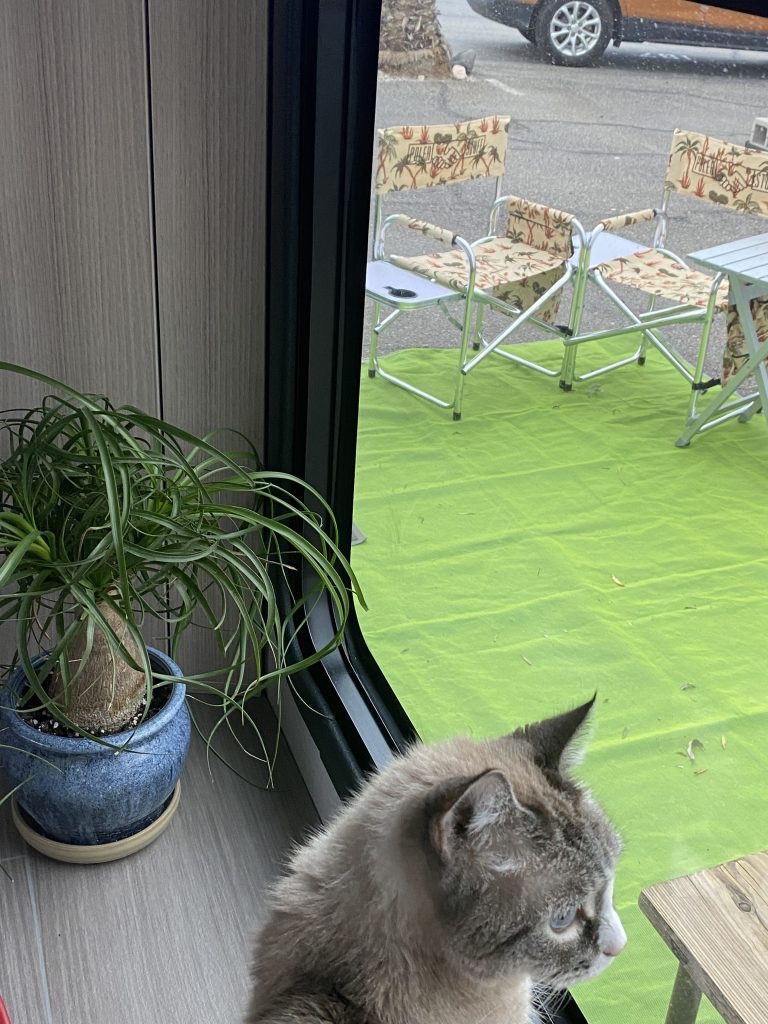
Cleo, who had never been an outside cat, enjoyed watching birds and chipmunks. She would run from side to side in the RV, looking for birds flying around outside. Surprisingly, she was never interested in going outside of the RV; we could leave the door open, and she would sit at the top of the stairs and look out.
Benefits of RVing with Pets
Teddy and Brownie are great icebreakers–allowing us to effortlessly ease into a new area, whether out for a walk in the RV park or on a trail. People often ask for the pups’ names and ask if they can pet them. Then, before you know it, we exchange information and plan to share more stories later around a campfire—a wonderful experience for all.
Pets also provide a sense of safety for solo travelers and families alike. A barking pup demands attention from his family and strangers and can alert to potential dangers. What Brownie and Teddy lack in awareness, they make up for in cuteness. On a hike in New Hampshire, the pups were lucky not to be stepped on by a moose crossing the trail. Neither of them had any clue a moose was so close!
Cleo
Cleo is our official security kitty and naps in different areas of the Leisure Travel Van. We travel in a Wonder Rear Lounge, perfect for our pets and us. We have two different set-ups for Cleo and the pup’s belongings, which take us just a few minutes to change. Cleo’s litter box is in the back of the couch in front of the sofa when we are driving. She shares the pup’s water dish, which is always tucked behind the passenger seat in front of the coach.

When we are stationary, we move her litter box to the front of the RV. We purchased a Rubbermaid container that fits perfectly on the floor in front of the driver’s side seat. Before beginning our travels, we taught her how to use a litter box that she jumps in and out of. This allowed us to alter the box size to fit nicely where we wanted. Additionally, most of the litter stays in the box. Because we have pups who would happily eat her food if we allowed it, we place her food dish in front of the passenger seat and restrict the dog’s access to the front of the RV. This set-up works just as well, whether we turn our seats around.
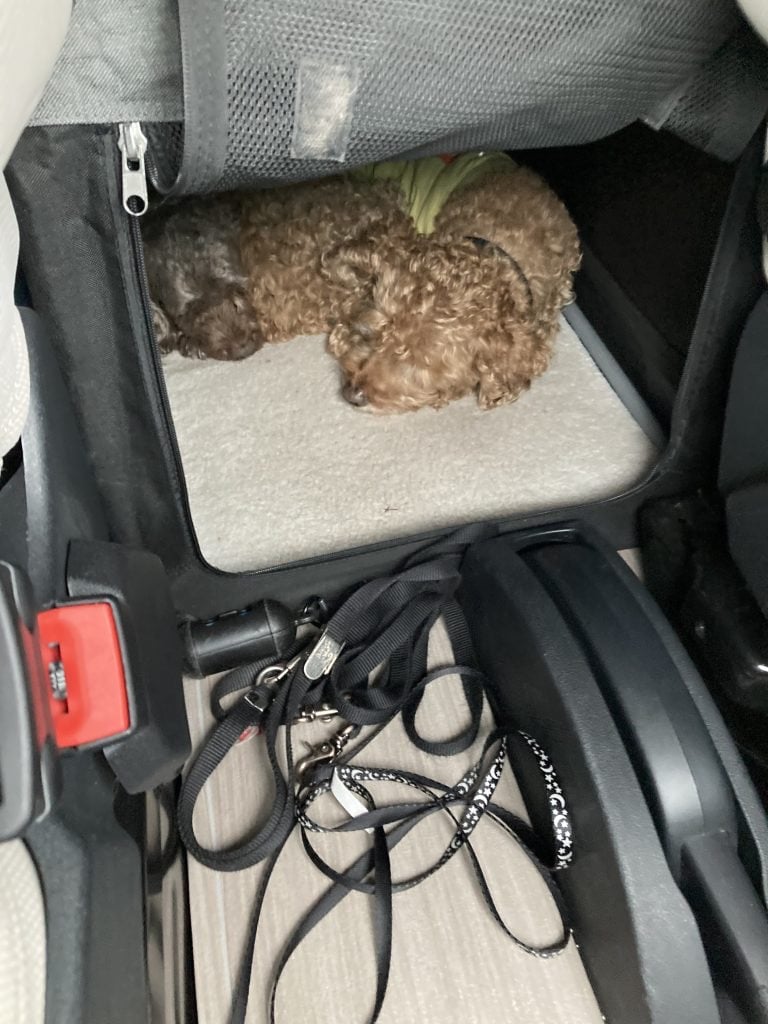
The pup’s set-up is even easier. Their bed, toys, water, and food always stay in the same place and are always available. But because they both have problems with arthritis and can no longer jump on and off the bed, we travel with their kennel. This is their home within our home. When we travel, the kennel sits just behind the seats, and they can look towards the front of the coach. When stationary, we move the kennel to the front passenger seat. Again, it fits easily with or without the seats turned.
Hiking with Pets
Hiking Memere is all about hiking and exploring, but before we were Hiking Memere. Jess and I were Teddy and Brownie’s moms, bringing them with us everywhere we could. These dogs logged miles on the trails and in our vehicles long before our full-time RV adventures began. Hotel rooms and elevators were everyday activities when we traveled with our daughter while she played travel team softball. From big cities to remote tenting spots ,the dogs have been loyal companions.

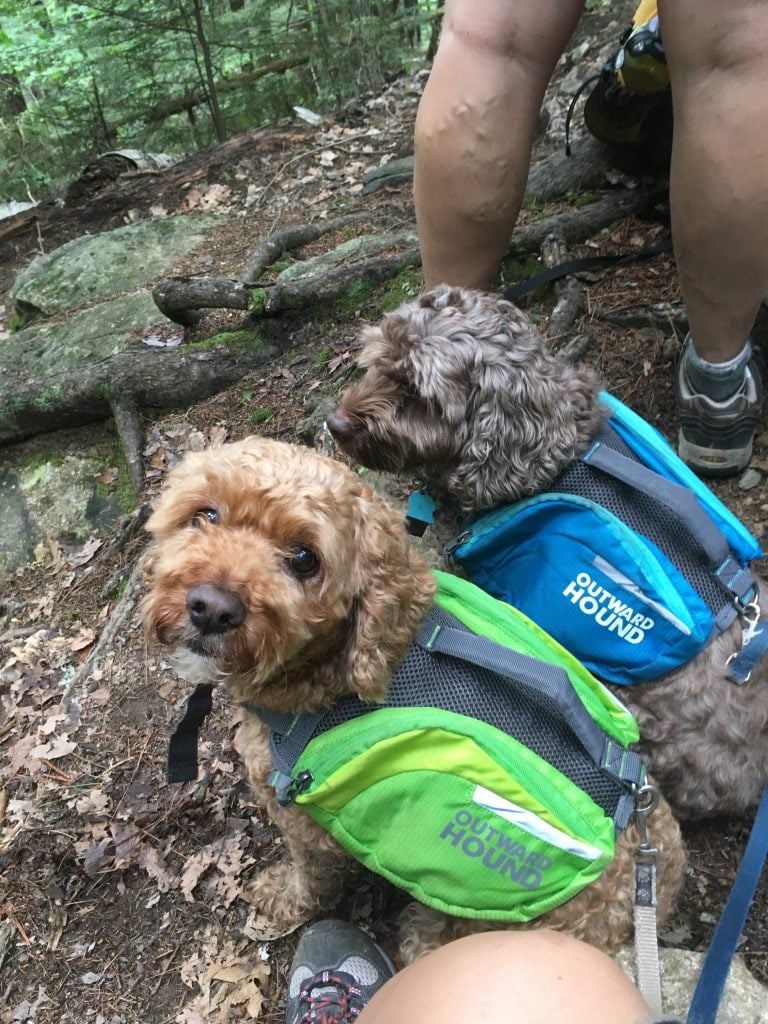
Mighty cute hikers in their youth, they accompanied us on most hikes and, despite their height, navigated some challenging terrain. Brownie’s short, rugged frame was perfect for long distances, and he never tired. Teddy was our difficult teenager, consistently trying to cut corners and push boundaries. He was also very dramatic and would often stop and lie down on the trail for no reason.
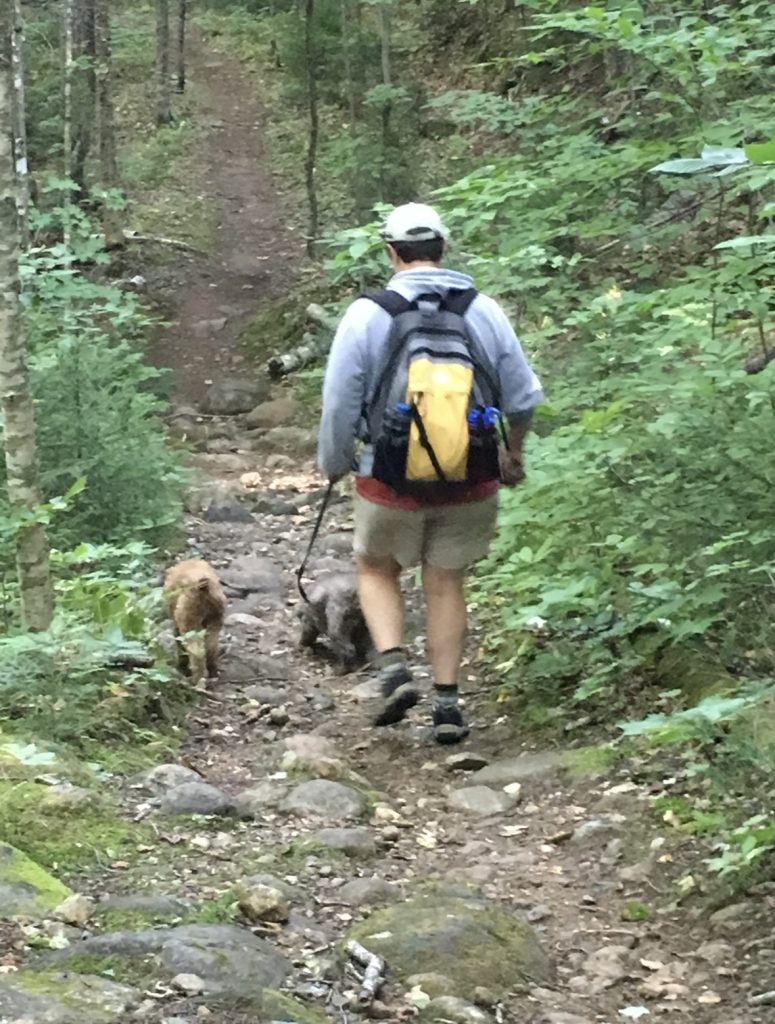
Unfortunately, I never kept track of the dog’s hikes. I wish now that I had. They hiked many of the 4000 footers in New Hampshire, the top .3 mile of Mt. Blue Sky in Colorado, an elevation above 14,000 feet, and many miles along the Appalachian trail on the east coast of the United States.
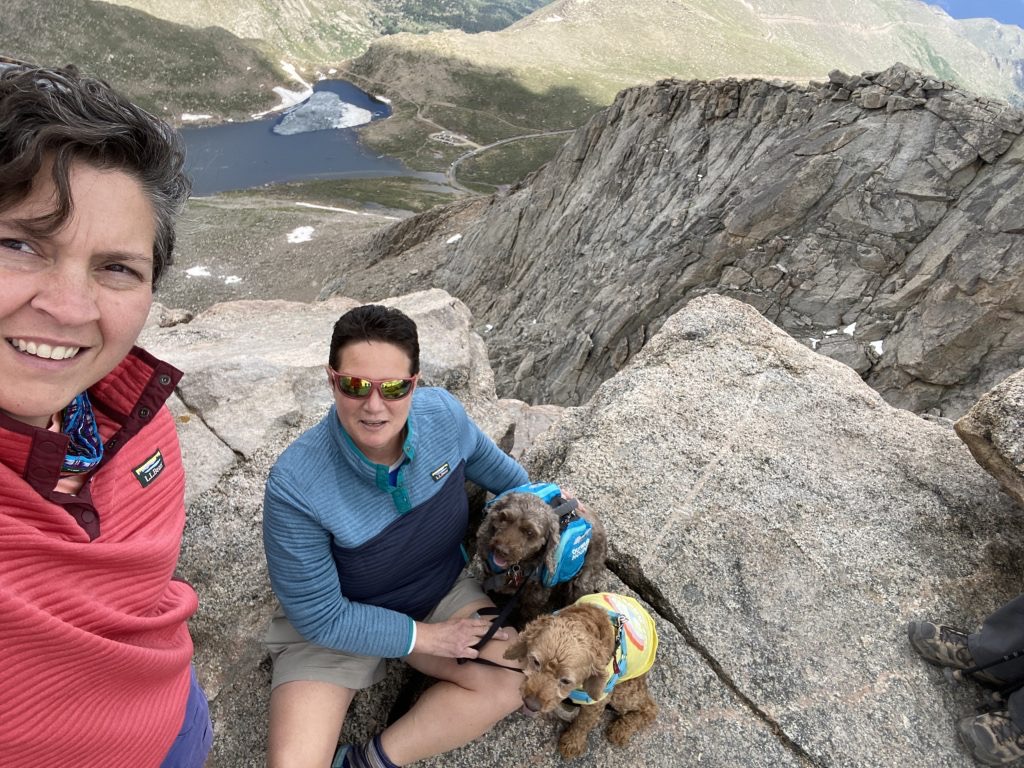
Mt. Blue Sky (formerly Mt. Evans) Colorado
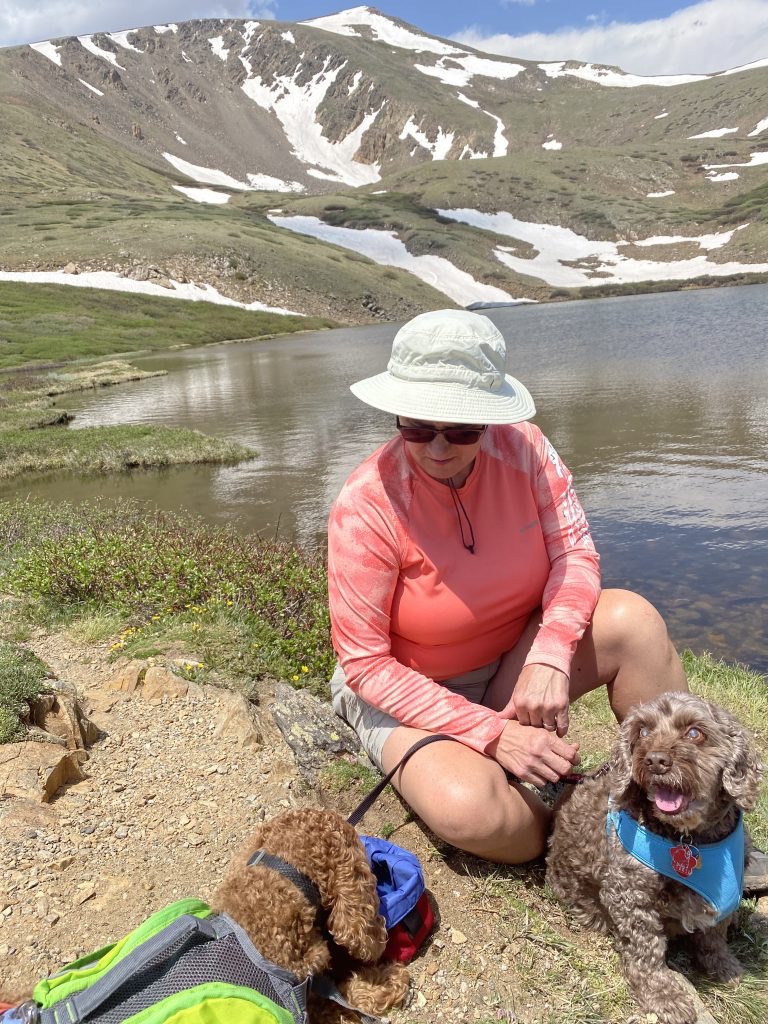
Square Top Lake, Colorado
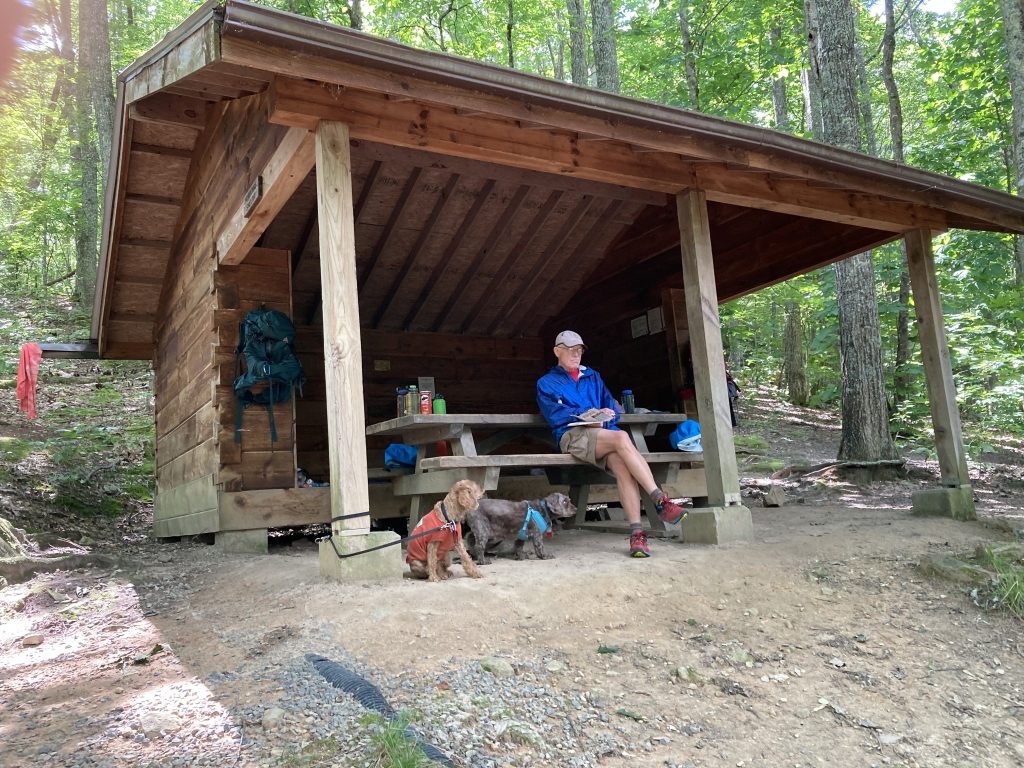
Hiking Options
As Brownie and Teddy aged, their hiking abilities gradually diminished. First, it was Brownie who was plagued by arthritis and lost his eyesight. Then Teddy, years later, began to also suffer from arthritis and a sore back, making hiking difficult for him. That is when hiking changed for us. Jess discovered K-9 Sport Sacks, and we purchased two. They allowed us to hike together again as a family.
Instead of the pups plodding beside us, we each carried one in a pack on our backs. The packs were an instant success. Teddy especially loved being in the pack. He was inches from me and could see everything. Teddy loves meeting other hikers along the trail. Many people have never seen a dog being carried in a backpack and want to say “Hello.” All of this additional attention is his favorite pastime.
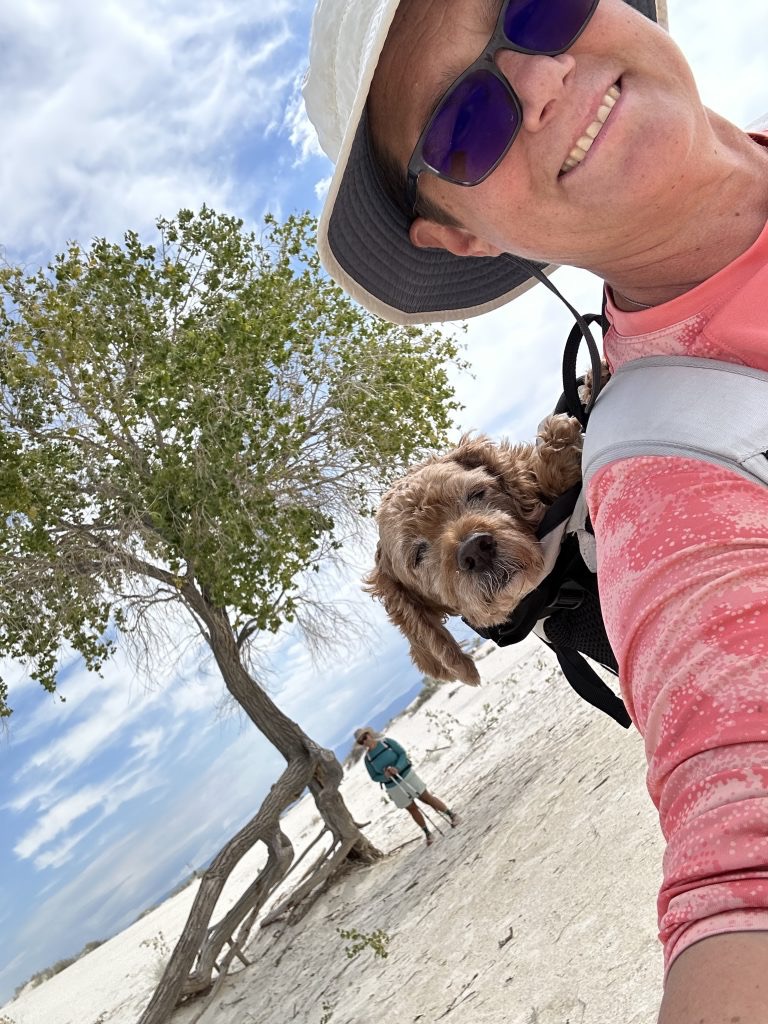
Over the last few years, both dogs have spent many miles in their packs exploring beside us. I have enjoyed carrying them and having the ability for them to continue our RV adventures with us. With the added benefit of keeping ourselves in good enough shape to carry a heavy pack.
Cleo is not much of an explorer, but she does have a leash and harness, which I think she hates. We did try a special backpack for cats which she tolerates. Cleo is very vocal and expresses her opinion about everything. Translated, I think she enjoys her time when we and the dogs are away from the RV and has the house to herself!
Kayaking
Kayaking might not be an activity you have thought about sharing with your pet. We were hesitant on our first kayaking adventure because neither dog enjoys the water. However, it was simple and an instant success.
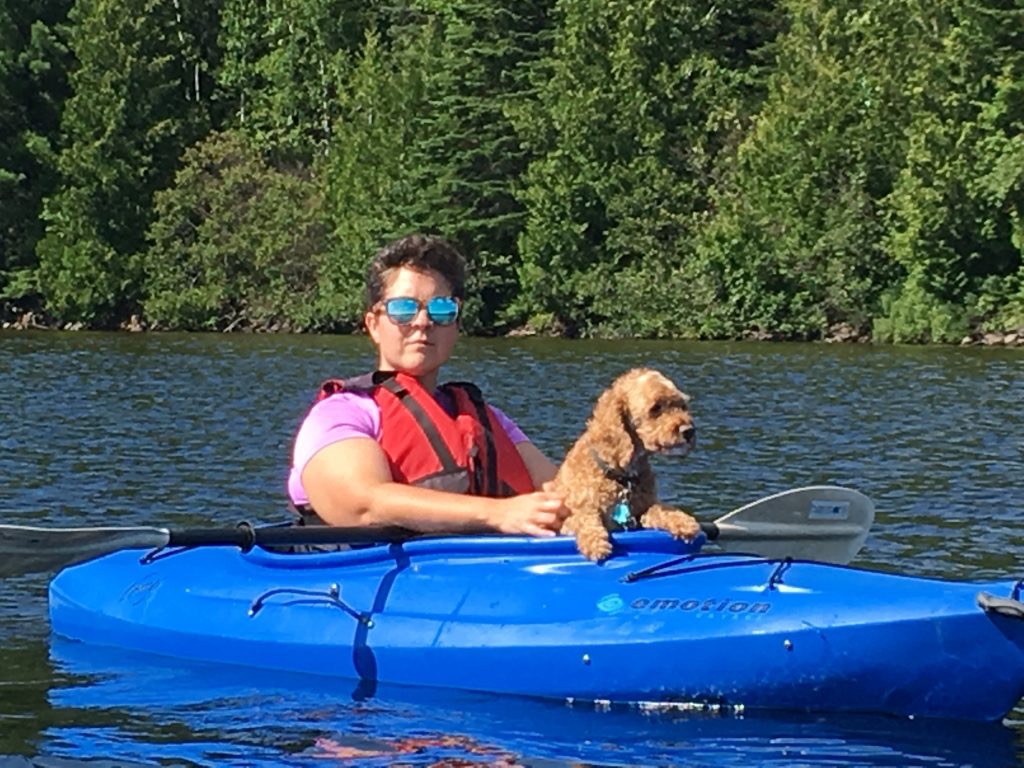
We were tent camping at Cliff Lake in the Great North Woods of Maine, a place I often visited with my Memere and Pepere as a child. Jess and I wanted to explore the lake with our kayaks, but we couldn’t leave the pups behind at our campsite because the area is so remote and wild. Therefore, they needed to learn how to kayak.
Possibly because they did not like the water, they never tried to jump out of our boats. They sat in front of us and enjoyed the breeze in their face. We stayed near shore on our first ride to ensure we were all going to be safe. At the time, there was no such thing as a dog life vest. When tired of looking at the sights, they sat down and enjoyed the ride.
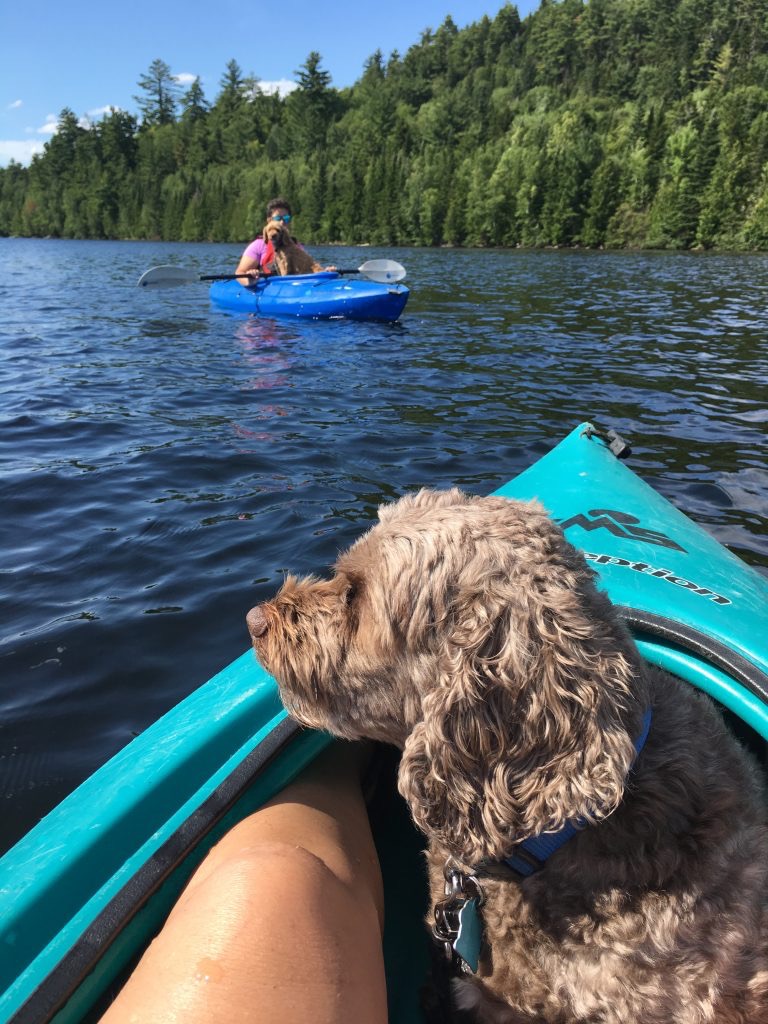
Over the years, the pups have accompanied us in kayaks and boats in lakes, rivers, and ponds. All with no problems. I realized early on that our pups were willing to participate in any of our crazy adventures because they felt safe by our side.
Biking
As our full-time RVing journey has progressed, we have added biking. Most parts of the country have various biking trails, with more and more opening. Numerous options exist, from protected city bike paths to rails being converted to trails. On a whim one day in Lake Havasu, Arizona, I decided to take Teddy with me on a bike ride.
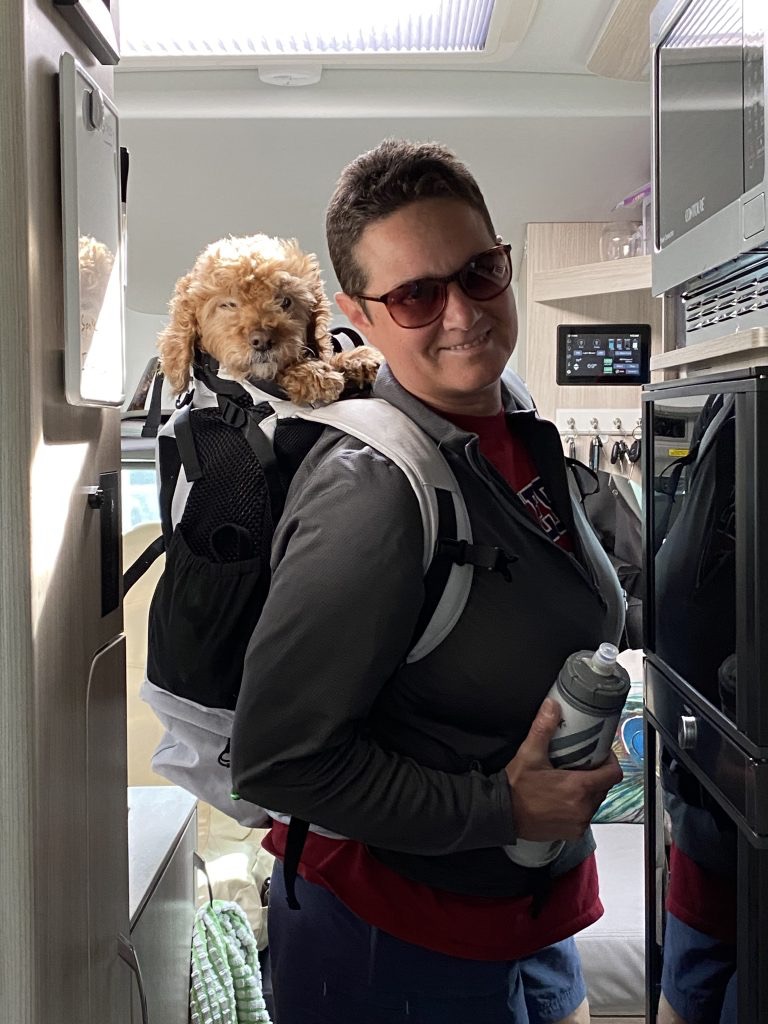
He was all excited when I grabbed his pack and loaded him up. When I picked up the bike and climbed on, he had a concerned look on his face. I stopped a couple of times to observe him, and within a half mile, he was hooked. He was sticking his head out, looking around me, as the wind blew in his face. His expression was priceless, like that happy dog in the car window. We rode just under ten miles on that first adventure.
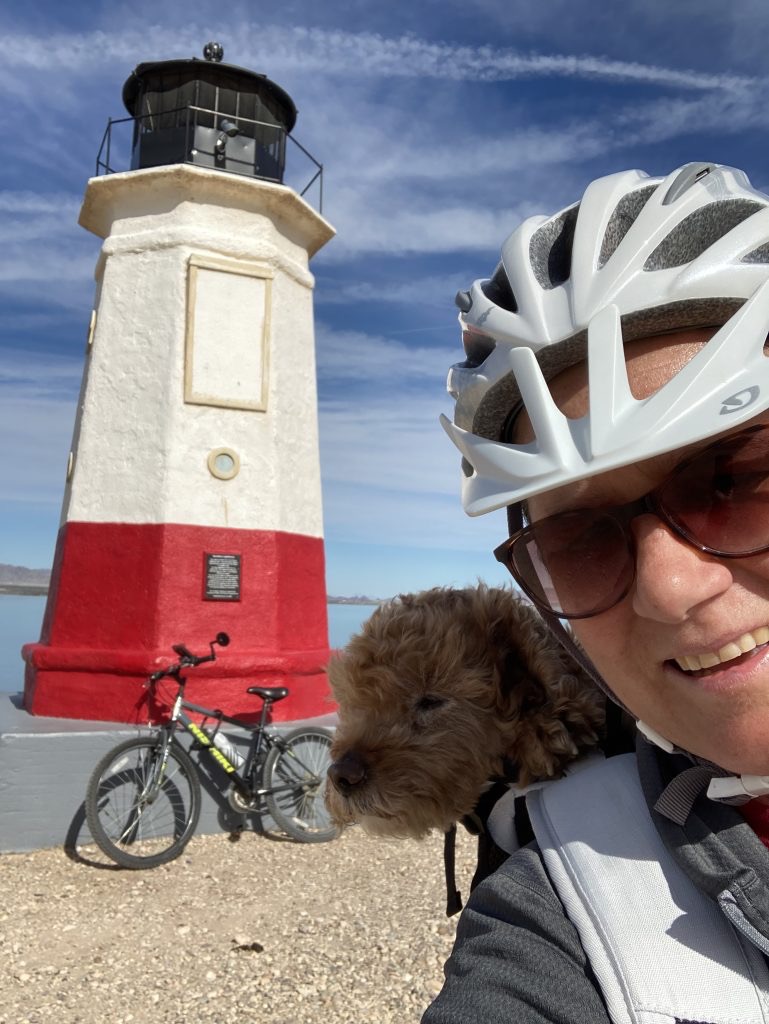
We see many dogs who bicycle in different ways with their owners. Baskets are standard for small pups, as well as pull behind child carriers, sometimes with more than one dog in them. I have seen a large dog run beside their owners more than once. Anyway you choose to bike with your dog, they will love it as much as Teddy does.
Dog-Friendly Restaurants
Our dogs have enjoyed eating out with us since they were young. We were fortunate to live in an area with many dog-friendly restaurants. After a long hike with the pups in the White Mountains of New Hampshire, stopping on the way home and enjoying a meal was wonderful. We were a little nervous the first time we ate out with our pups. I was worried one of them would have an accident or bark excessively. We ensured they had a potty stop before entering the restaurant.
Once seated, I shortened their leashes and placed a dog on each side of me. Fortunately, our dogs are not typically barkers but are very nosy, especially Teddy. They settled quickly, laid down under my chair, and watched everything around us. We have never fed our dogs table scraps, and they do not beg for food, which is helpful in these restaurant situations. Of course, if something accidentally fell off the table, Brownie would be the first to catch it!
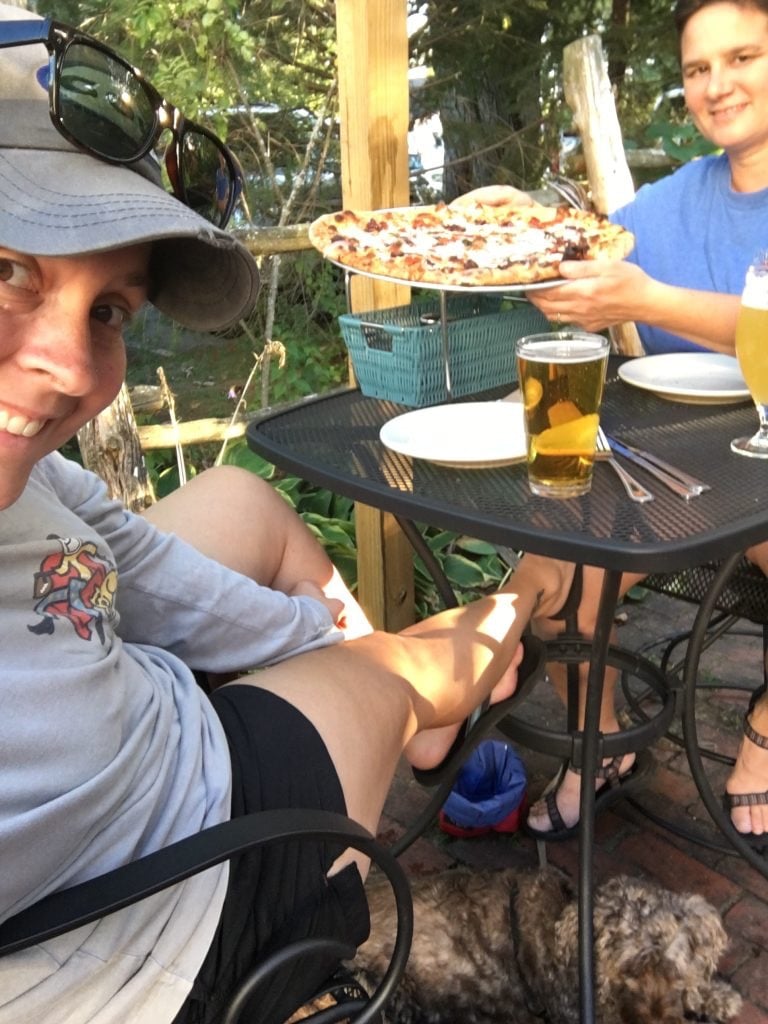
Over the last sixteen years, with our pets, even more businesses and restaurants have become dog-friendly. Many restaurants now have patios and specific areas to seat their canine customers. They often provide water dishes, and some even have dog treats. They welcome all well-behaved patrons and dogs alike. Finding these places has been wonderful and offers us the opportunity to eat out or shop while not having to leave our pups behind.
Dog Parks
Dog parks are becoming common at RV resorts and community parks. We have visited very few places over the last couple of years of travel where a dog park is not within walking distance. These parks provide a place for pups of all sizes to run free. In most places, large and small dogs are separated into different spaces.
Dog parks provide safe spaces for dogs to exercise and socialize and are often the best places to meet neighbors. Every day at the Las Vegas RV park, where we spend time in the winter, I meet someone new. Many people are just visiting for a few days. However, many seasonal people spend large amounts of time in the area. This connection provides the rare familiarity feeling that is not common in our full-time journeying style of travel.
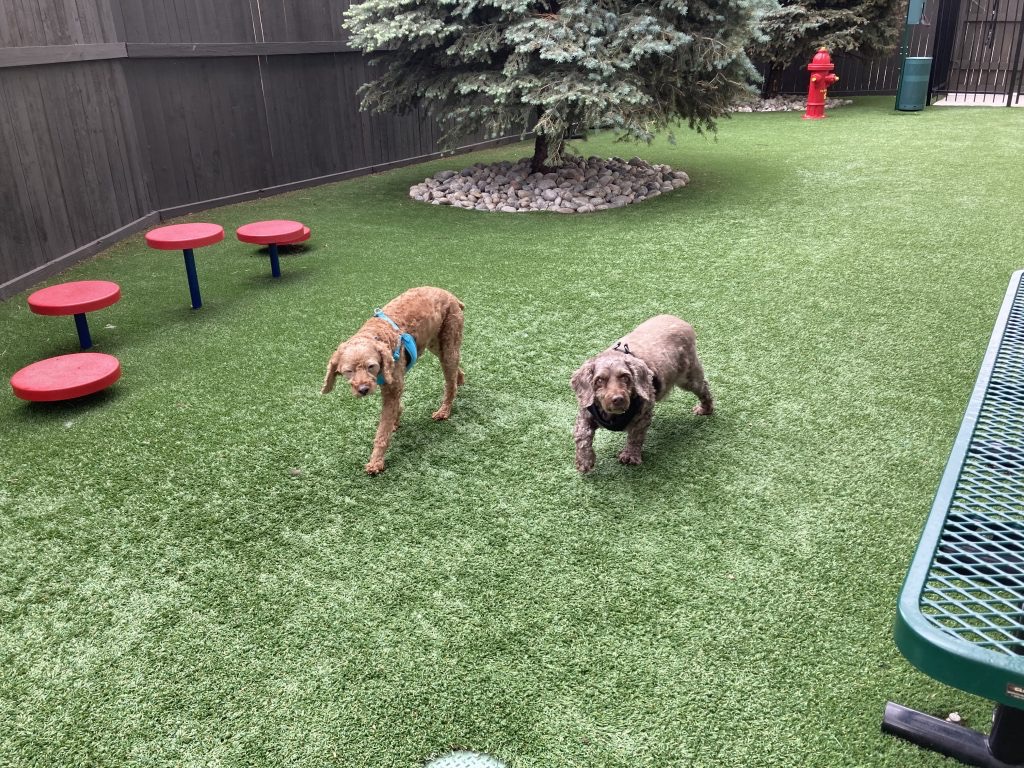
Pet Hazards
Thorns, hot pavement, air temperature, sharp rocks, and snakes are just a few of the hazards when RVing in the desert with pets. Some minerals can hurt your pet’s paws, or they could ingest them when licking their paws. Many areas of the country have poison ivy and oak, which pets can run through and later transfer to their humans. Ticks are also a challenge in many areas as well as mosquitos.
Fortunately, most pets with proper veterinary care will avoid any problems with tick or mosquito-transmitted diseases. Leashes in areas with poisonous plants or cacti will help pets avoid any contact. There are special classes available to teach dogs snake safety when hiking. Boots of all sizes are available to protect against sharp rocks, thorns, and hot or cold surfaces. They even make life jackets for pups these days.

Air temperature is one of the most challenging things to keep our pets safe from. The hot sun heats up all surfaces, which could burn pets’ feet and lead to possible overheating situations. RVs have less square footage and, therefore, can heat up quickly, similar to a car. Proper awareness of weather conditions, both hot and cold, is necessary to keep our pets safe.
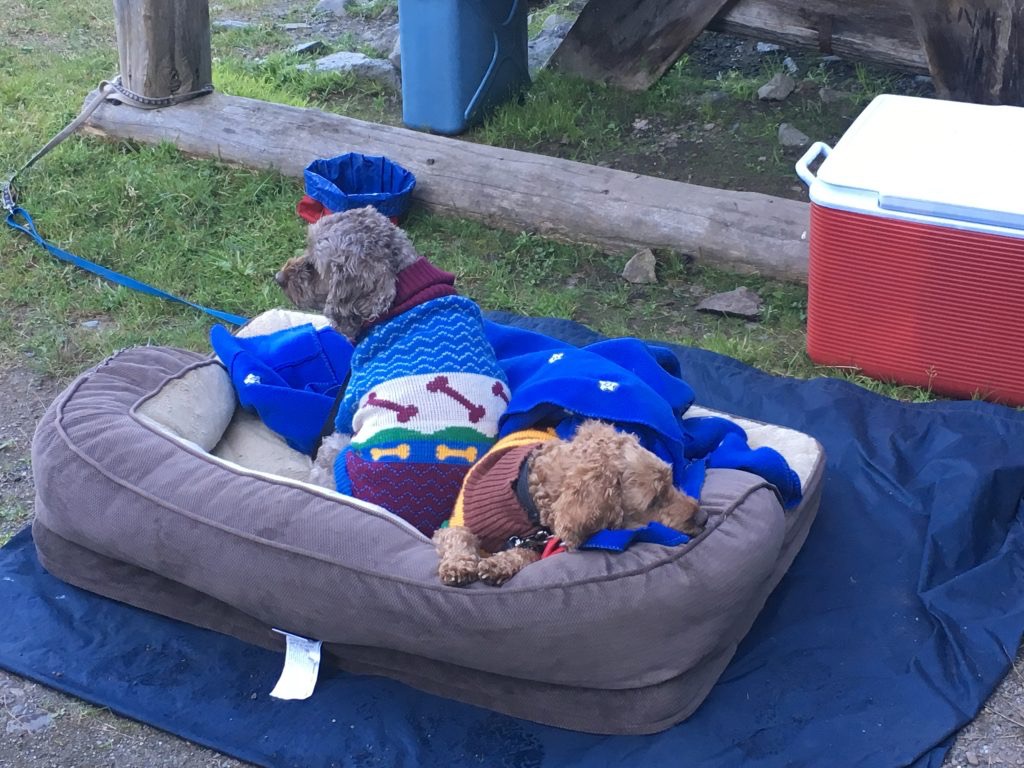
Elevation also affects pets. More water should be offered in hot or higher elevation situations, and their behavior should be observed for unusual things. Cold can also be dangerous for many pets. Teddy wears a sweater for much of the winter. Know your pet and plan for their comfort and safety.
Veterinary Care on the Road
With elderly pets, some may find veterinary care difficult. We have spent time in rural and urban areas and have had access to veterinary offices no more than an hour from wherever we have been. It isn’t possible for us to have a long-standing relationship with any one vet while traveling full-time; however, we have had positive experiences whenever we need one’s services.
To make the process smoother for us and our pets, we do a few things. First is carrying all of their medical records with us. Second, we make sure to schedule their annual checkup in an area where we will be spending extra time and ensure we stay up to date on all of their testing and vaccinations. Lastly, we have plenty of their food and medications, additionally paying close attention to their eating, drinking, voiding, and overall appearance.
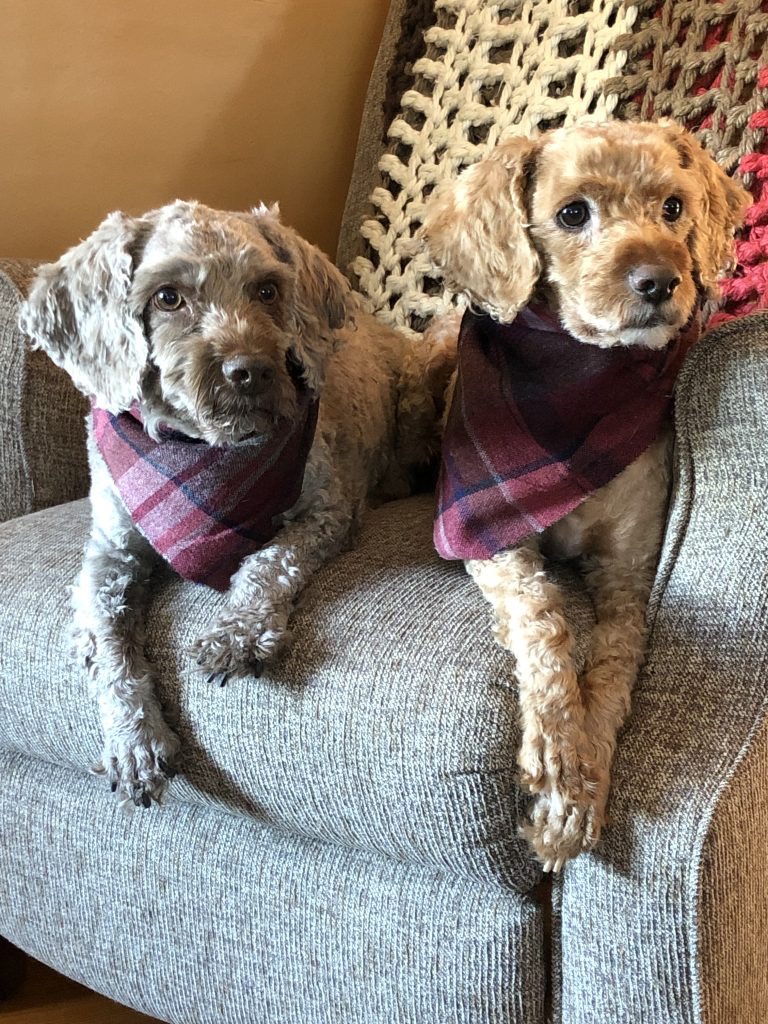
National Parks
National Parks are complicated when it comes to pets. I recommend you look specifically at the rules relating to any park you would like to visit. Typically, the rules in national parks allow pets to accompany their families to campgrounds. However, aside from paved campground roads, pets are not usually allowed on trails. Compounding the problem, many National Park campgrounds are primitive and cannot connect to power; if there is power, they are booked well in advance.
These limitations make camping and visiting National Parks difficult in hot temperatures when air conditioning is required. We have combatted the challenge by spending more money to find full hook-up RV sites outside the National Parks. This gives us a window of freedom when we can hike and explore while the pups enjoy the climate control of the RV.
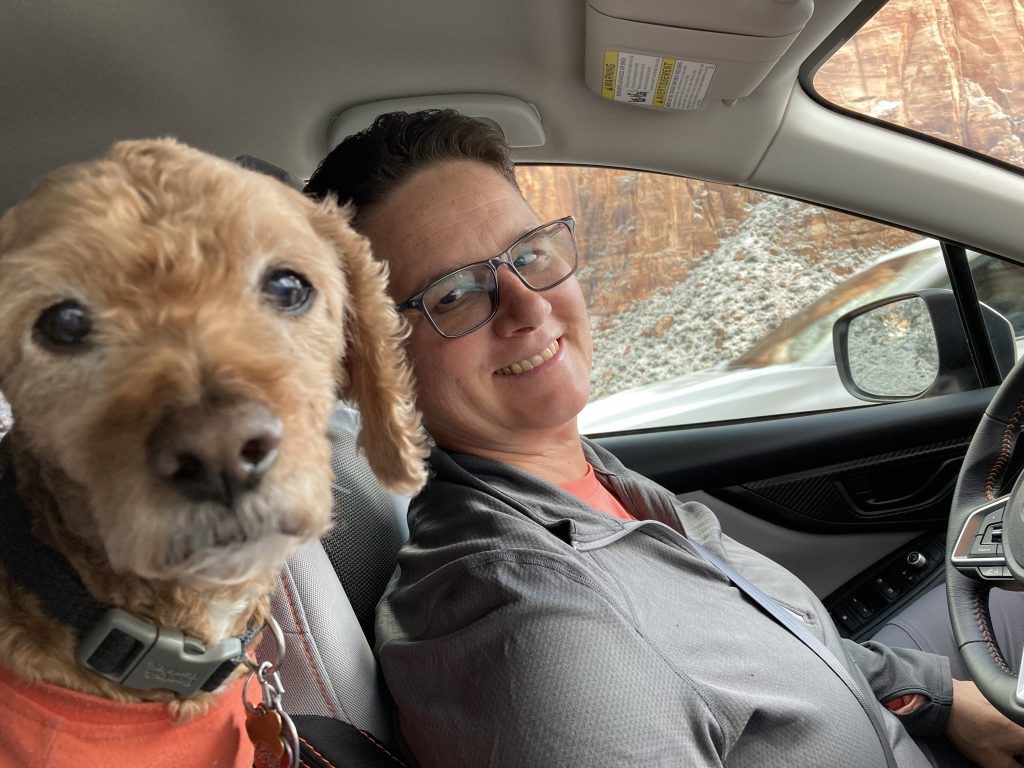
We visited Zion National Park in a snowstorm with the pups because we knew we would not be hiking. The day was spent exploring in the car and seeing amazing places, and we had a great day. A similar challenge was presented when we visited Yellowstone National Park. Our campsite had no power, and the temperatures were too warm to leave the pups behind. Jess and I took turns seeing the sights. It took us longer, but each of us saw the features we wanted, and the pups were always safe in the car’s climate control with one of us.
But mostly, we avoid National Parks and travel to National Forests, Recreation areas, and State and City Parks, which are much more favorable to pets. We searched these places and enjoyed the freedom of having our pets with us.

Boarding Options
Throughout our years in our stick and brick, we have had the ability to always hire dog sitters and never had to use a boarding facility when we’ve traveled. There are many wonderful facilities and people out there, but we have preferred to let the pups maintain their routine and stay at home. Especially now that the animals are elderly, we are not going to use a boarding facility; however, we have noticed many near the National Parks.
Traveling to the Gila Cliff Dwellings National Monument this summer was a bit confusing for us. We had researched the park and knew many of the trails were dog-friendly. When we arrived to hike the trail to the Cliff Dwellings, there was a large sign stating no dogs, but there were complimentary first come, first serve kennels available. We were not expecting this situation and were uncomfortable leaving our pups unattended in a kennel.
Instead, again, we decided to divide and conquer. I stayed with the pups, and Jess hiked the trail, taking videos the whole way for me to watch. The kennels were wonderful and shaded. If I had a big dog and a lock I could have used on the kennel, it would have been a welcomed benefit. Boarding is a personal decision, not unlike using a daycare for child care. There are many options, and finding facility reviews online is easy.
Another possible option is using one of the many private individuals, which we find at most RV parks, who offer pet care or walks. These people typically leave a business card in the RV resort office and come with great references.
Know Before You Go
RVing with pets is as easy as living with pets in your home. The pet will need to adapt like their owners do when traveling. Sometimes, potty breaks are in a dog park or a busy truck stop. The ability to do their business anywhere their human offers will become second nature with some practice. Cleo did not like using her litter box when we traveled down the highway. She learned to use it when we stopped to refuel and use the restroom ourselves.
Our pups are very social, loving all other pets and humans alike, which has helped throughout our travels. New situations do not scare them as long as we are close by. It is extra work for us to ensure their safety and comfort, and sometimes extra costs, but it is well worth the effort.
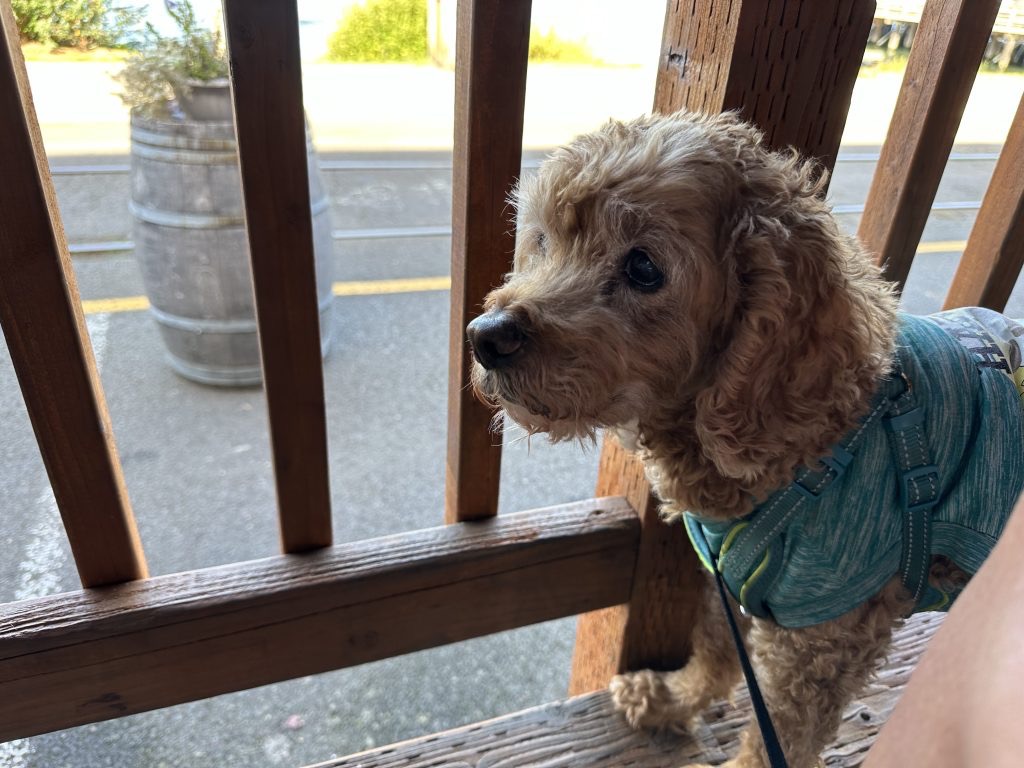
Know the rules of where you are going to keep yourself and your pups safe. Follow the rules. Pick up after your pets. Use leashes to protect your pet from hazards and others. Buy the proper equipment to keep your pets healthy and safe. Enjoy their shenanigans. Embrace the accidents or emergency walks in the middle of the night. RVing and pets are the perfect combination.
Live Simple, Live Happy.



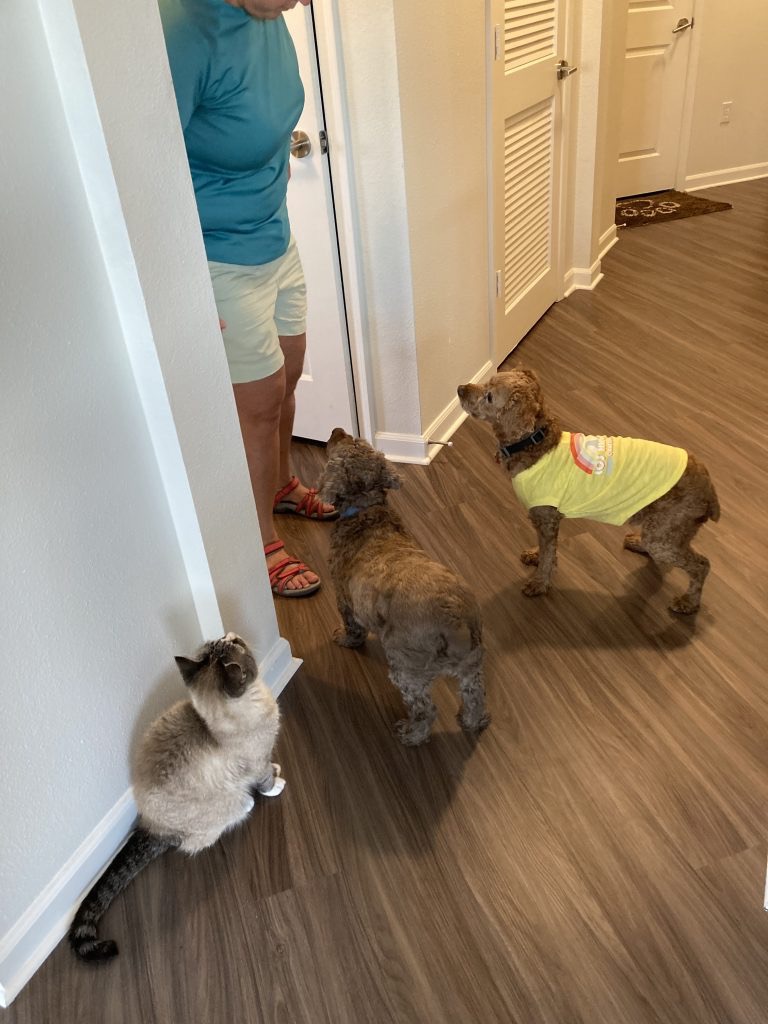
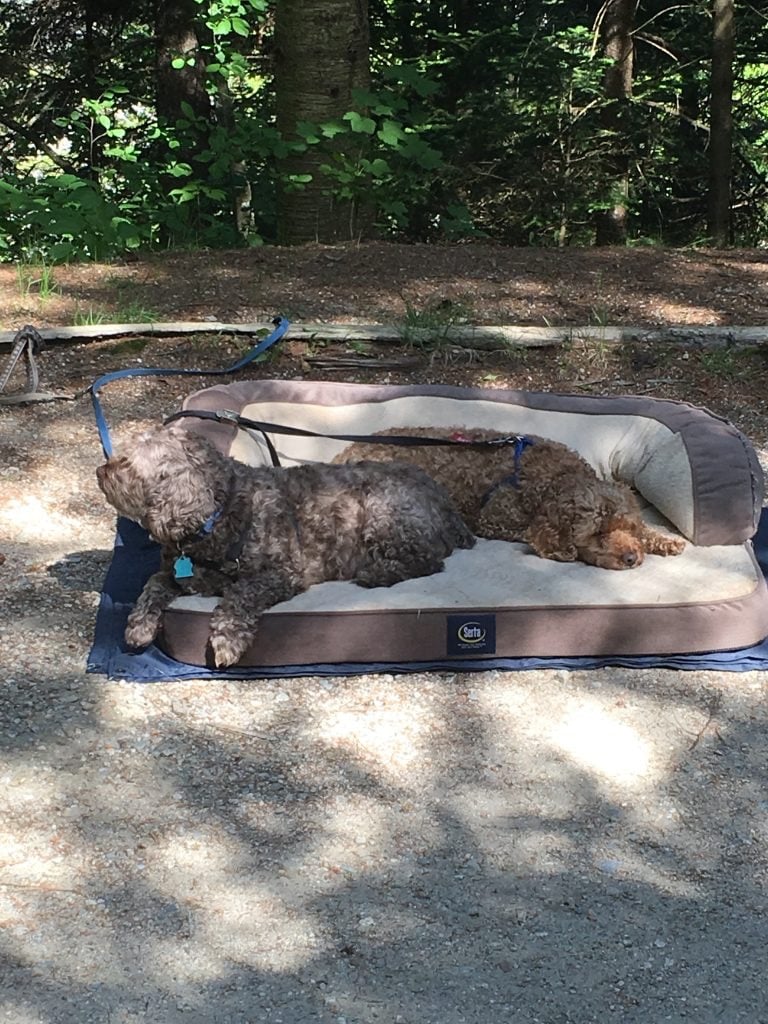
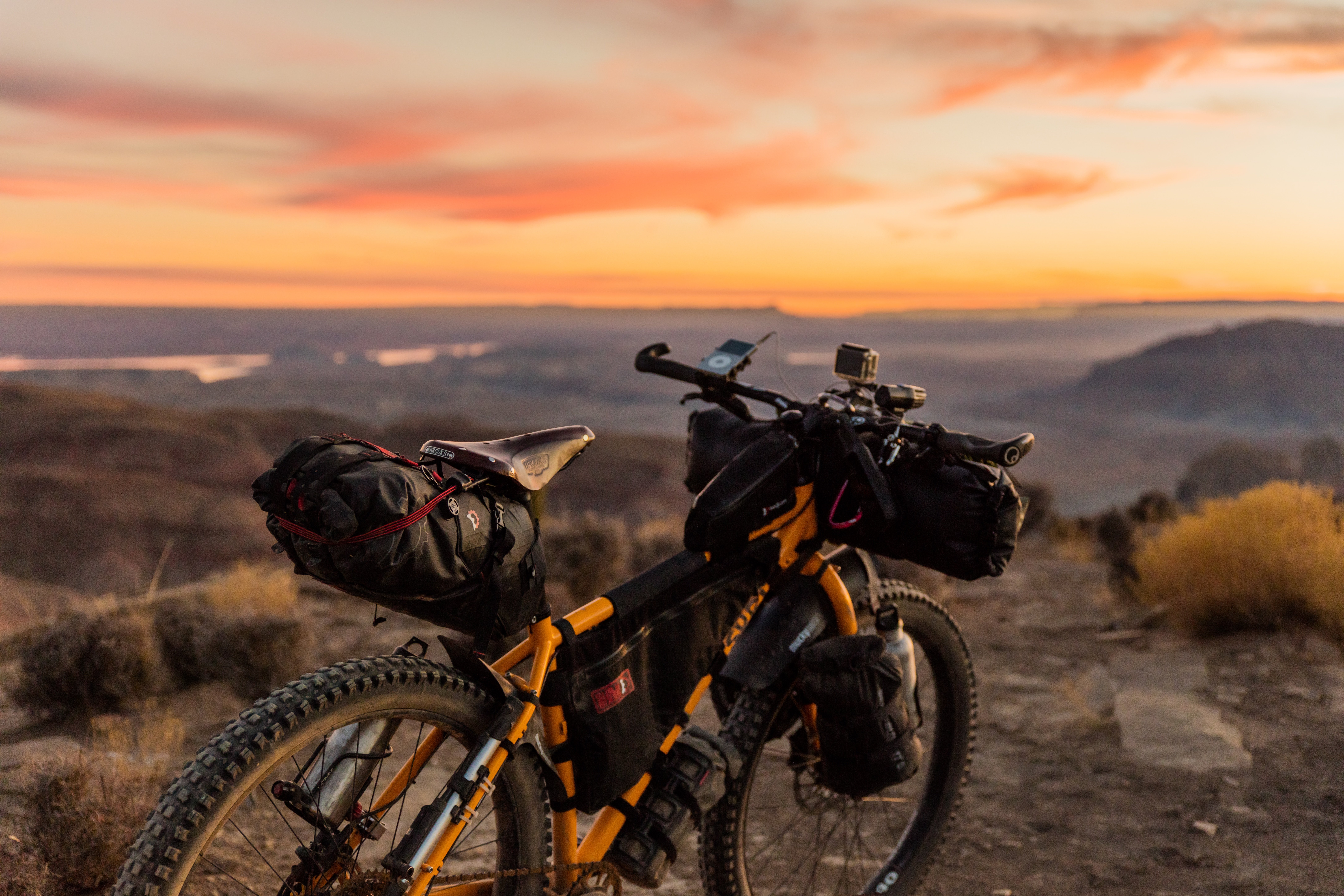
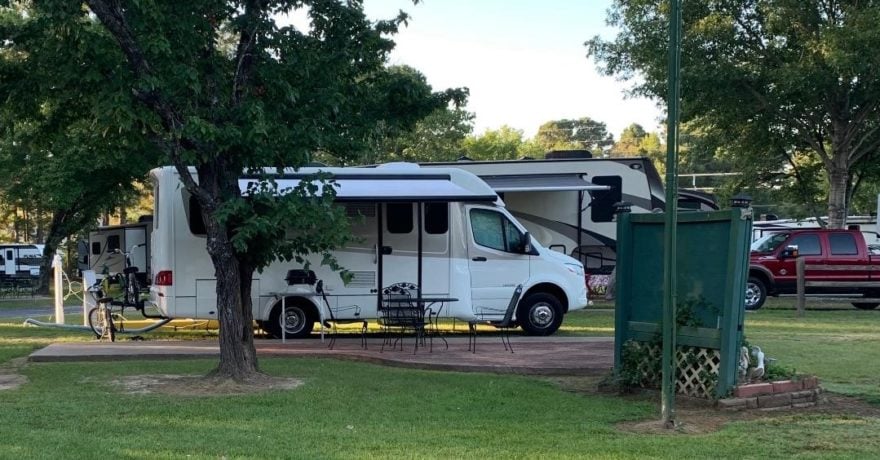

Comments